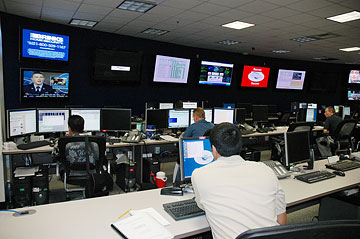 GREGG K. KAKESAKO / GKAKESAKO@STARBULLETIN.COMKeith Nance works at one of the computer terminals at Pacific Theater Battle Watch on Ford Island. The facility, which was inaugurated May 8, monitors data, voice and other communication networks in the Pacific region. It helps Navy and the Marine Corps identify potential communications problems before they occur. CLICK FOR LARGE |
|
Military tech support reaches far
Computer networks from Arizona to Iraq are monitored at a Ford Island facility
The military's Pacific region covers more than 100 million square miles stretching from the deserts of Arizona through Hawaii and parts of Asia to the Persian Gulf.
There is an urgent need to maintain a steady stream of uninterrupted classified and unclassified information in a network spanning the region with about 65,000 computers and 120,000 users.
That task falls to more than a dozen civilian employees of Electronic Data System who maintain round-the-clock operations at the Navy's Pacific Theater Battle Watch, which was inaugurated on May 8.
Vinnie Madsen, vice president of the Navy Marine Corps Intranet Pacific Operations, said the "Pacific Theater Battle Watch provides tighter links between the warfighting command centers of the Navy and the Marine Corps. We saw the need to partner with the warfighting commands and provide situational awareness for exercises and real-world events.
"Commanders are able to speak with the Battle Watch staff on a secure line any time, 24 hours a day."
Madsen said the need for such a center arose because the warfighting commands at Camp Smith and Makalapa started using the Navy Marine Corps Intranet for operational missions.
Now, Madsen said, the facility does more than just operate a 24-hours-a-day help line. The center also constantly monitors classified and unclassified voice, video, cellular and data communications links.
The goal is to identify problems with the data and communications networks before the user calls in for help, he said.
Greg Davis, a Battle Watch captain, said he's seen all the problems the communication system could experience. "They range from localized issues, such as a problem with a single computer, to issues that impact an entire command. You never know what you are going to get," he said.
Davis said workers in the center at Ford Island work 12-hour shifts. There are nine 60-inch LCD and plasma screen monitors that line one wall of the operations center. On the wall, cable TV news programs or information on the status of communications networks throughout the Pacific can be viewed at the same time.
During a visit last week, Madsen pointed to one of the large monitors that showed the status of all the unclassified information networks in the Pacific. "It automatically goes from green to yellow and then red, if a problem is detected," he said.
In the past, if the command centers at Pacific Command, the Pacific Fleet or Marine Forces Pacific had problems with their computers or their communications network, they had to contact technicians in Virginia. That could mean delays in fixing the problem because of the different time zones and staffing.
The $1 million Pacific Theater Battle Watch is just the latest innovation to the Navy Marine Corps Intranet that became operational six years ago. The system worldwide connects more than 400,000 computers and half a million users. The center is located in what was once a 35,000-square-foot World War II hangar that survived the 1941 Japanese attack on Pearl Harbor. Because the hangar is considered a historic structure, no changes could be made to its exterior. More than $65 million was spent in fabricating basically what was a shell within the hangar to house the center.
Madsen said the $22 million Navy Marine Corps Intranet system was developed so that the Navy and the Marine Corps would be operating in the same secure communications and data network.
"Every major command," Madsen said, "had their own network. It would be a safe statement to say that we took 1,000 networks and brought it down to one."
The Oahu Navy Marine Corps Intranet network, with its 60 computer server farms on Ford Island, operates the unclassified and classified e-mail and file storage communications operations from Yuma, Ariz., to Okinawa.
When the Ford Island computer information center came online in 2002, the Navy said it had more than enough memory space to store all of the books and reference materials housed in the Library of Congress -- more than 120 million items taking up 530 miles of bookshelves in the largest library in the world.
Other networks operations are in Quantico and Norfolk, both in Virginia; and San Diego. The entire operation is considered one of the largest information technology projects and is unique to the Navy and the Marine Corps.
Nearly 200 civilian workers are employed here by Electronic Data System, which is headquartered in Plano, Texas, and headed by onetime presidential candidate Ross Perot.
The Ford Island headquarters also houses the warehouse and maintenance operations for computers used by the Navy and the Marine Corps in the Pacific. "We fix most of our equipment here," Madsen said, "rather then send them back to the mainland."

